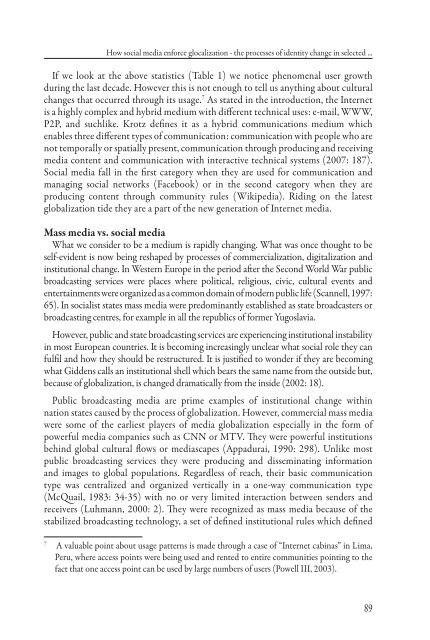free download in pdf format - Culturelink Network
free download in pdf format - Culturelink Network
free download in pdf format - Culturelink Network
Create successful ePaper yourself
Turn your PDF publications into a flip-book with our unique Google optimized e-Paper software.
How social media enforce glocalization - the processes of identity change <strong>in</strong> selected ...<br />
If we look at the above statistics (Table 1) we notice phenomenal user growth<br />
dur<strong>in</strong>g the last decade. However this is not enough to tell us anyth<strong>in</strong>g about cultural<br />
changes that occurred through its usage. 7 As stated <strong>in</strong> the <strong>in</strong>troduction, the Internet<br />
is a highly complex and hybrid medium with diff erent technical uses: e-mail, WWW,<br />
P2P, and suchlike. Krotz defi nes it as a hybrid communications medium which<br />
enables three diff erent types of communication: communication with people who are<br />
not temporally or spatially present, communication through produc<strong>in</strong>g and receiv<strong>in</strong>g<br />
media content and communication with <strong>in</strong>teractive technical systems (2007: 187).<br />
Social media fall <strong>in</strong> the fi rst category when they are used for communication and<br />
manag<strong>in</strong>g social networks (Facebook) or <strong>in</strong> the second category when they are<br />
produc<strong>in</strong>g content through community rules (Wikipedia). Rid<strong>in</strong>g on the latest<br />
globalization tide they are a part of the new generation of Internet media.<br />
Mass media vs. social media<br />
What we consider to be a medium is rapidly chang<strong>in</strong>g. What was once thought to be<br />
self-evident is now be<strong>in</strong>g reshaped by processes of commercialization, digitalization and<br />
<strong>in</strong>stitutional change. In Western Europe <strong>in</strong> the period aft er the Second World War public<br />
broadcast<strong>in</strong>g services were places where political, religious, civic, cultural events and<br />
enterta<strong>in</strong>ments were organized as a common doma<strong>in</strong> of modern public life (Scannell, 1997:<br />
65). In socialist states mass media were predom<strong>in</strong>antly established as state broadcasters or<br />
broadcast<strong>in</strong>g centres, for example <strong>in</strong> all the republics of former Yugoslavia.<br />
However, public and state broadcast<strong>in</strong>g services are experienc<strong>in</strong>g <strong>in</strong>stitutional <strong>in</strong>stability<br />
<strong>in</strong> most European countries. It is becom<strong>in</strong>g <strong>in</strong>creas<strong>in</strong>gly unclear what social role they can<br />
fulfi l and how they should be restructured. It is justifi ed to wonder if they are becom<strong>in</strong>g<br />
what Giddens calls an <strong>in</strong>stitutional shell which bears the same name from the outside but,<br />
because of globalization, is changed dramatically from the <strong>in</strong>side (2002: 18).<br />
Public broadcast<strong>in</strong>g media are prime examples of <strong>in</strong>stitutional change with<strong>in</strong><br />
nation states caused by the process of globalization. However, commercial mass media<br />
were some of the earliest players of media globalization especially <strong>in</strong> the form of<br />
powerful media companies such as CNN or MTV. Th ey were powerful <strong>in</strong>stitutions<br />
beh<strong>in</strong>d global cultural fl ows or mediascapes (Appadurai, 1990: 298). Unlike most<br />
public broadcast<strong>in</strong>g services they were produc<strong>in</strong>g and dissem<strong>in</strong>at<strong>in</strong>g <strong>in</strong><strong>format</strong>ion<br />
and images to global populations. Regardless of reach, their basic communication<br />
type was centralized and organized vertically <strong>in</strong> a one-way communication type<br />
(McQuail, 1983: 34-35) with no or very limited <strong>in</strong>teraction between senders and<br />
receivers (Luhmann, 2000: 2). Th ey were recognized as mass media because of the<br />
stabilized broadcast<strong>in</strong>g technology, a set of defi ned <strong>in</strong>stitutional rules which defi ned<br />
7 A valuable po<strong>in</strong>t about usage patterns is made through a case of “Internet cab<strong>in</strong>as” <strong>in</strong> Lima,<br />
Peru, where access po<strong>in</strong>ts were be<strong>in</strong>g used and rented to entire communities po<strong>in</strong>t<strong>in</strong>g to the<br />
fact that one access po<strong>in</strong>t can be used by large numbers of users (Powell III, 2003).<br />
89



